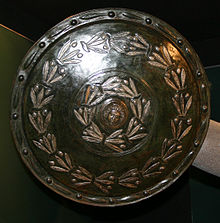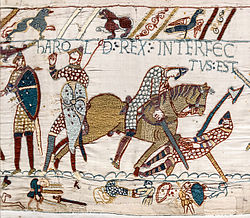Shield
A shield is the oldest active defensive weapon used for protection from offensive weapons and for attack. It has been known at least since Sumerian times (III millennium BC, in Mesopotamia) and it will be used in the West until the 17th century, when individual firearms became general, thus becoming obsolete. It is commonly wrapped in the left arm and helps to cover the body from the attacks without impeding the use of the right arm to counterattack. The shield has been used by almost all human cultures for defense in fighting, both at a distance and in melee, due to its versatility in covering the fighter from attacks with thrown or brandished weapons.
It underwent great changes both in materials and in its shape, either over time or by geographical region, adapting to technological or tactical changes to ensure maximum protection for combatants. Each time a new and more lethal weapon was introduced, the shield thickened or the quality of its materials increased, until gunpowder, which launched armor-piercing projectiles at great distances, rendered its use useless on the battlefield. In numerous regions of the globe where the tribal system still persists (Oceania, Africa, etc.), shields were used at the beginning of the 20th century.
From the 20th century, the shield was once again used within many police forces in the fight against riots, in which it serves as protection against the launches, and also as a support to repel the protesters (usually carried by the police on the front line). It is made of plastic material, generally transparent, in order to allow vision and simultaneously protect the face.
Another modern version is also used by special or elite forces particularly for siege and control of hostage situations. They are generally made of reinforced steel and ceramic.
History
Variety and evolution of materials
Any object that allows to oppose to the adversary a surface behind which there is protection, could be called shield with all propriety, and sometimes it was "fortune", assuring a minimum protection with a minimum cost. Thus, the Helvetian militias had simple bundles of straw in the early days.
Wood prevailed, as a frame, throughout history for its preparation. It could be manufactured in different ways depending on the combatant's protection class, from a simple wicker braid, light and resistant to perforation as in the Thracian pelta or as in numerous African models, with a thick structure of shaped and joined pieces, like the aspis koile of the hoplite; or it could be made of a single piece of carved wood as in Oceania. In the equipment of organized armies it was covered, at least on its external face, with a second material that gave it better resistance to penetration and allowed it to maintain its integrity during blows:
- Leather: one of the oldest materials used for this weapon, attested since the Sumerian era. This material when tensed on a support and drying, eventually boiled, acquires a very good resistance to the penetration of arrows or spears, is usually superimposed several layers to provide a "arm", being more effective than a thick and united layer of the same matter.
- Linen: material that replaces the leather, also offers very good resistance after being macerated in a vinegar and salt cooking; it was already used in Ancient Greece.
- Copper: used by the sumerians, it was placed on the external face in spaced disks, destined to reinforce the shield. Their disadvantage is the malleability of the metal.
- Bronze: excellent copper alternative, more resistant, offered better protection; it was generalized in all kinds of armament, particularly in that of the Greeks, who used it in all its equipment (panoplia), even after the advent of iron. It covered the entire outer surface of the shield; it was reserved mainly for those of large size, for heavy armed fighters such as the counterparts (see also the hoplistic system).
In the Byzantine Empire the oval shield prevailed. In the West, and from the 10th century, the almond-shaped one was quite common, attributed to the Normans, with a sharp lower point to stick it into the ground when halting the troops. At the end of the 13th century until the 16th century it tended to the equilateral triangular shape.
Ordinarily, the shields were covered with skin and painted with emblems or particular signs that gave foundation to the coats of arms. In the 16th century metal bucklers with reliefs and inlaid details of great luxury were used for gala tournaments, while some divisions of troops infantry used them made of iron or wood covered with skin only in the sieges of enemy cities, losing all its importance later the defensive shield transformed exclusively into heraldic.
In Western culture, especially, the shield has served as a support for identifying elements of the individual who carried it, with the composition of the coat of arms with its crests, giving rise to the art of Heraldry.
Today's shields can cover the entire body of a police officer against the impact of bullets and other heavy objects thrown at them. They are commonly transparent, and some similar to bucklers are also used. In some Asian countries, riot police use round shields made of highly resistant vegetable fibers.
Types of shields
The ancient shields are:
- Adarga: oval shield formed by two leathers sewn together.
- Aspis: shield used by ancient Greek infantry (hoplits).
- Broquel: small circular shield of Asian origin, usually leather with metallic edge; at the back contained a cazolet in the middle to protect the hand that held it.
- Shield: large shield used by the Greeks and Romans, originally circular form.
- Pavés: oblong shield covering almost the entire body of the fighter.
- Water tap or tear: by its elongated drop form that improved the protection of the advanced leg.
- Rodela: round metal shield used until the 16th century in Europe.
- Targe: Scotland's traditional shield.
- Tarja: Medieval shield covering the entire body.
- Scutum: shield of the Roman Empire used by heavy infantry (legionaries). Starting from the Greek Clipeus, in circular form, the scutum It had a more adapted form to the form of the human body. It could be oval or rectangular (door shape), and it was made of solid wood or composed of a covered wooden frame and of metal layers. Seen from the side, the scutum takes a curved form that better protected from attacks coming from the flanks. Although its curved profile remained unchanged over the centuries, its shape changed slightly. During the times of the Republic it was oval, and so it stayed for a few years during the Empire, until the rectangular form began to be used. It had a great size and constituted an excellent defense for the Roman legionaries, without its weight becoming a burden or a sneeze for the bearer. Refugied after him, the Legionnaire neutralized the encometides of the enemies, and then, from his dense position, attacked with his gladiusOr Roman short sword. Its use was essential in turtle formations, commonly used by Roman legions during combat. Its use was lost in favor of the oval shield (of barbaric inspiration) progressively, from the third century.
Parts of a medieval shield
The medieval shield was mainly made up of:
- Umbo. The umbo was the piece that is placed in the outer central part of the shields, to give an offensive character to that weapon originally designed for defensive purposes.
- Enarmas. They were the grip leather straps attached to the back of the shields.
- Tiracol. They were the leather straps that were sometimes provided with a belt that served to carry the shields.
- Concierge. It was the bar located at the bottom that served to reinforce the edges and in some cases to nail the shield.
- Radial reinforcements. They were the metal reinforcements around the shield that improved their resistance.
Contenido relacionado
Bartolome de las Casas
London
Country code




